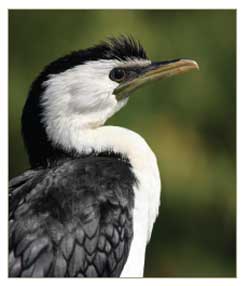
Kangaroo Island is reknown for it’s migratory bird populations. The White Lagoon wetland system supports a number of these migratory birds as well as permanent bird populations. The following includes a description of the birds that can be found on White and Rush Lagoons.
Hoary-Headed Grebe-Poliocepalus poliocepalus
The Hoary-headed Grebe is found in all states and territories of Australia as well as in New Zealand. It is generally absent from the central arid regions of Australia.
The Hoary-headed Grebe is usually found away from the shoreline in large open waters, which may be estuarine, brackish or freshwater.
Little Pied Cormorant- Phalacrocorax melanoleucos

Almost any body of water in Australia, large or small, marine or fresh is likely to be frequented by the Little Pied Cormorant.
The Pied Cormorant is a large black and white bird with a long, grey, hooked bill and black legs and feet.
The Pied Cormorant is found throughout mainland Australia. It is more common in the south and along the coast of south-western Australia and is not found in the driest parts of the interior. It is also found in New Zealand.
Rush Lagoon is frequented by the Little Pied Cormorant due to the yabbies present as this forms part of their diet.
Australasian Shoveler-Anas rhynchotis
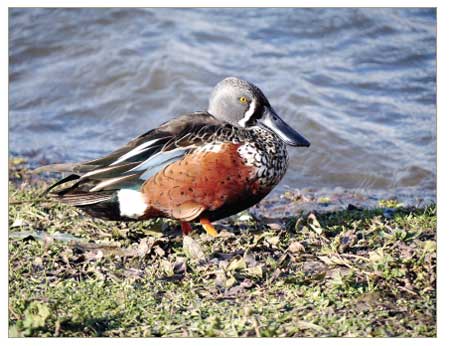
The Australasian Shoveler is a low-floating, dark headed duck, with a low sloping forehead blending to a heavy, square-cut, shovel-tipped bill.
The Australasian Shoveler is found in all kinds of wetlands, preferring large undisturbed heavily vegetated freshwater swamps. It is also found on open waters and occasionally along the coast.
In Australia these ducks are dispersive, but little is known about their movements. In New Zealand they are highly mobile.
The Australasian Shoveler is a filter feeder, using special lamellae (grooves) along the edges of the bill to filter insects, crustaceans and a variety of plants from the water.
Chestnut Teal-Anas castanea
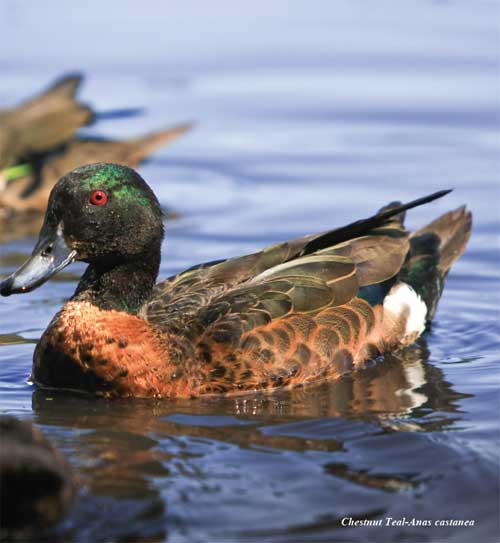
The Chestnut Teal is found in south-western and south-eastern Australia. In the east, it is found from Rockhampton, Queensland to Ceduna, South Australia, being most common in New South Wales, Victoria and Tasmania.
The Chestnut Teal is found on wetlands and estuaries in coastal regions, and is one of the few ducks able to tolerate high salinity waters, although it still needs fresh water for drinking. It will also use open freshwater lakes, reservoirs and sewage ponds during dry seasons. Some movement occurs between breeding and non-breeding areas, but many birds do not move far.
The Chestnut Teal is often found in paddocks on Straraer grazing for insects, especially in the spring period when insects are at their highest with the warmer weather. This particular species can be seen on the edge of Rush Lagoon filtering the water surface or stripping seeds from plants.
Grey Teal- Anas Gracilis
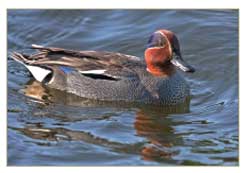
Grey Teals are common in all sheltered watered areas. These include fresh, brackish and salt water and the birds can be found on the smallest area of water in the driest of areas. The most favoured habitat type is timbered pools and river systems of the inland areas, where these birds can be found in quite large numbers. The Grey Teal is grey to brown in colour and can be found on both Rush and White Lagoons, so are suited to both fresh and salt water systems. Their breeding can take place at any time of the year, the rate of population turnover is high with some birds living to eight years, however most on average live for 20 months.
During periods of drought, Grey Teal are very mobile in search of water, often travelling great distances.
Pacific Black Duck-Anas superciliosa
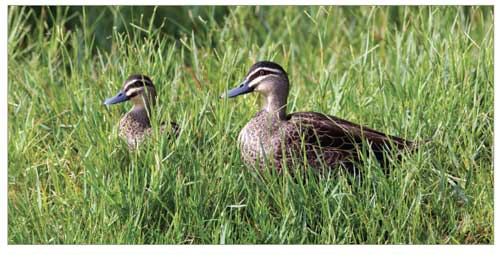
The Pacific Black Duck is mostly mid-brown in colour, with each feather edged buff. The head pattern is characteristic, with a dark brown line through the eye, bordered with cream above and below and a dark brown crown. The Pacific Black Duck is found in all but the most arid regions of Australia. Outside Australia, its range extends throughout the Pacific region.
Every coastal stream and lagoon in Australia has its fair share of the Pacific Black Duck. They are probably more widely distributed in Australia as a breeding species than any other.
The Pacific Black Duck is a surface-feeding duck taking both plants and animal food from the water. Rush Lagoon is an ideal environment for the Pacific Black Duck. Although these ducks are randomly nomadic, following floods and evacuating drought stricken areas, they are nonetheless permanent on some waterways around Australia.
The higher concentration of the Pacific Black Ducks on Rush Lagoon occurs in winter-spring, when he water levels are at their highest and aquatic plants are mature for feeding. It is at this time that most of the breeding occurs.
Pink Eared Duck-Malacorhynchus membranaceus
The Pink Eared ducks are common in most waterways of inland Australia. These ducks are nomadic and able to breed at any time.
The Pink Eared Duck is not mistakeable for any other duck.
This duck is found throughout Australia but only occasionally in Tasmania.
The Pink Eared Duck is found in timbered areas near water. It prefers shallow, temporary waters however, open wetlands support large flocks. It is a highly dispersive and nomadic species. This particular species of duck is able to survive in brackish and freshwater lakes, however most commonly seen on the edge of lakes feeding on insects, water fleas and freshwater algae.
Pink Eared Ducks are birds of the inland swamps and will fly great distances in search of water. Huge flocks often reach the coast in dry years.
Pink Eared Ducks feed in shallow warmish waters. The highly specialised bill is fringed with fine lamellae (grooves) to filter out the microscopic plants and animals which make up the bulk of its diet.
Freckled Duck-Stictonetta naevosa
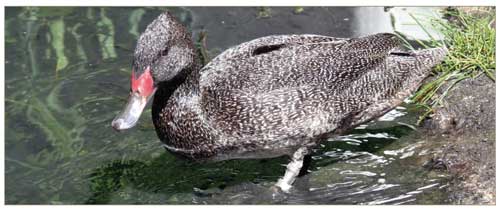
The Freckled Duck is a dark greyish-brown duck with a large head that is peaked at the rear and has a distinctive narrow and slightly upturned bill. This species is considered one of the rarest water ducks in the world.
The Freckled Duck is found primarily in the south east and south west of Australia. The Freckled Duck prefers permanent fresh water swamps and creeks with heavy growth of cumbungi (bullrushes), lignum or tea tree. The melaleuca halmaturorum (tea tree) is an ideal habitat for the Freckled Duck and the conservation of Rush Lagoon has increased this species of tree. During drier times, the Freckled Duck moves from ephemeral (not permanent) breeding swamps to more permanent waters such as lakes, reservoirs, farm dams and sewerage ponds.
Freckled Ducks feed at dawn and dusk and at night on algae, seeds and vegetative parts of aquatic grasses and sedges and small invertebrates.
Australian Shelduck-Tadorna tadornoides
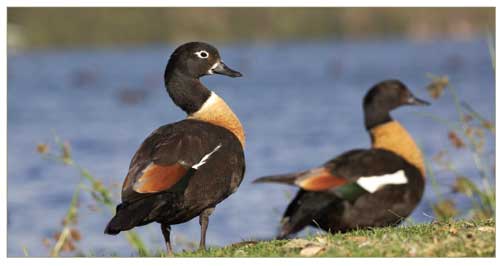
The Australian Shelduck is a large, brightly coloured duck with a small head and bill and lives in lowland areas such as large brackish lakes of the coats, which are their preferred habitat. They also congregate in deep freshwater lakes, large lagoons like Rush Lagoon and billabongs.
Australian Shelducks are usually unmistakable, with the upright stance and dark head contrasting with the white neck ring.
The Australian Shelduck prefers fresh waters and if in a saltwater habitat, needs to be within easy reach of fresh water. The majority of Australian Shelduck are seen on Rush Lagoon, as opposed to White Lagoon due to varying water quality and they are often seen in pairs.
The Australian Shelduck grazes on green grass on land or in shallow water. It also eats algae, insects and molluscs.
The clearing and conversion of some areas to cropland and pasture has led to an increase in some local populations of the Australian Shelduck. Breeding territories are often established around farm dams.

Australian Shelducks grazing in Quail paddock, Stranraer, 2013. They feed on plants in shallow water or on land.
Musk Duck-Biziura lobata
The male Musk Duck is the largest of Australia’s ducks and has a powerful build.
Musk Ducks tend to be found in deep freshwater lagoons, with dense reed beds. They are normally seen singly or in pairs, but may form medium to large groups in the winter. Flight usually takes place at night.
Despite their bulky appearance, Musk Ducks are excellent divers and search underwater for the majority of their food. They mainly feed on animals, including aquatic insects, crustaceans, snails, shellfish, fish, frogs and ducklings, but some seeds of aquatic plants are also eaten on occasion.
Blue-billed Duck-Oxyura australis
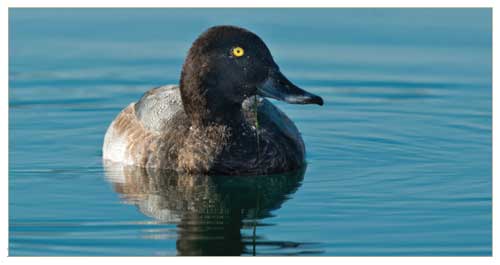
The Blue-billed Duck is endemic to Australia, being found in the temperate wetlands of the southeast and south-west parts of the continent.
The Blue-billed Duck is almost wholly aquatic, and is seldom seen on land. Non-breeding flocks, often with several hundred individuals, congregate on large, deep open freshwater dams and lakes in autumn. The Blue-billed Duck feeds almost entirely by diving. It takes aquatic insects including chironomid fly larvae, caddis flies, dragonflies, flies and water beetle larvae. They may also eat the seeds, buds, stems, leaves and fruit of a wide variety of plants. Feeding occurs in permanent areas of clear fresh water
Double-banded plover-Charadrius bicinctus
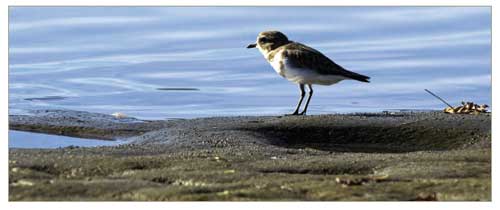
In Australia, the Double-banded Plover is found both along coastal shores, bays, estuaries and inlets. Their inland habitat tends to be large lakes with salt or brackish water, such as the White Lagoon wetland system, often seen on the edges eating insects and other invertebrates. After breeding in New Zealand the Double-Banded Plovers arrive in Australia during January and February. Between August and January the Double-banded Plovers fly back to New Zealand to breed.
Red-capped Plover-Charadrius ruficapillus
The adult male Red-capped Plover has a bright reddish chestnut crown (centre of crown can be grey-brown) and nape, and grey-brown mantle.
The Red-capped Plover is widespread throughout Australia.
The Red-capped Plover is found in wetlands, especially in arid areas, and prefers saline and brackish waters.
The Red-capped Plover is resident. Movements are poorly known, but it may move between the coast and inland wetlands.
The Red-capped Plover may be seen foraging for molluscs, small crustaceans and some vegetation, on mudflats, sandy beaches and salt-marshes.
Red-kneed Dotterel-Erythrogonys cinctus
The Red-kneed Dotterel is a small, plump wader with relatively long legs. It has a black cap covering the eye that reaches from the upper bill to the lower hind neck.
Red-kneed Dotterels are found throughout mainland Australia and southern New Guinea.
Red-kneed Dotterels are found in wetlands, lagoons and swamplands, preferring fresh water and areas prone to flooding.
The Red-kneed Dotterel is resident but probably moves long distances to find wetlands.
The Red-kneed Dotterel feeds on aquatic insects, larvae and seeds. It probes the mud along shorelines, as well as wading and sometimes swimming while feeding.
The Red-kneed Dotterel is secure. However, human disturbance, urban development and even cattle trampling over the eggs has had an effect on breeding in some areas.
Black-fronted Dotterel-Elseyornis melanops
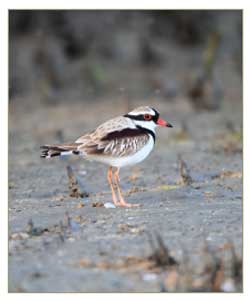
The Black-fronted Dotterel is a small wader with a distinctive black face-mask and breast-band and prominent chestnut scapulars (shoulder feathers). The Black-fronted Dotterel is widespread throughout Australasia and is found on temporary water systems and thus is nomadic for this reason.
The Black-fronted Dotterel is found in the shallow margins of wetlands, lakes, rivers, sewage farms, storm drains and marshes. It is normally always near freshwater and is not often seen on the coast.
The Black-fronted Dotterel eats small molluscs as well as aquatic and terrestrial insects. Often found on the edge of Rush Lagoon in pairs or singular.
Hooded Plover-Thinornis rubricollis
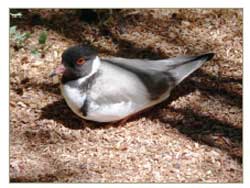
The Hooded Plover is found along coastal areas of southern Australia. There numbers have been in decline over the past few years, maybe as a result of increased coastal use of beaches by man and loss of habitat. Hooded Plovers are often seen in paddocks over Stranrar, especially during the winter months.
Whiskered Tern- Chlidonias hybrida
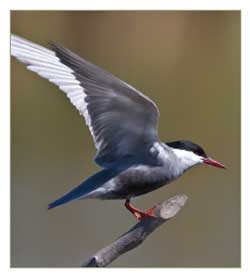
The Whiskered Tern is a small, tubby marsh tern with a slightly forked tail. The Whiskered Tern in breeding plumage has a black crown and white cheeks and sides of neck. The Whiskered Tern is also known as the Marsh Tern or Black-fronted Tern
The Whiskered Tern prefers shallow terrestrial freshwater wetlands, freshwater swamps, brackish and saline lakes, floodwaters, sewage farms, irrigated croplands and large dams.
Whiskered Terns are migratory and nomadic. In Australia generally, they are found on the coast and the interior, but are only vagrant in Tasmania. Large numbers of Australian birds migrate into Indonesia and South-East Asia, mainly via the top end.
When they arrive at Rush Lagoon they can be seen dipping to the surface catching aquatic insects in small groups. This is evident during the late spring and early summer period.
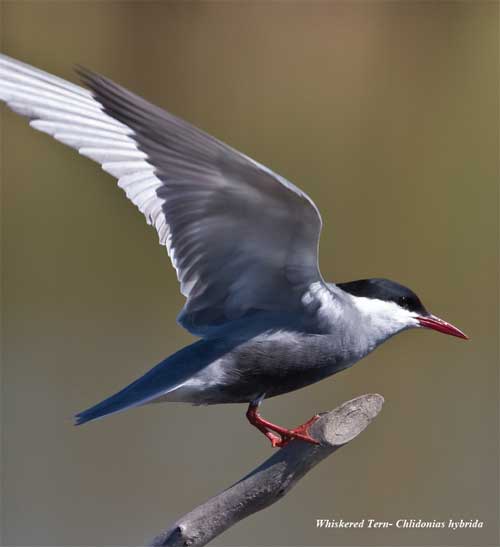
Cape Barren Goose-Cereopsis novaehollandiae
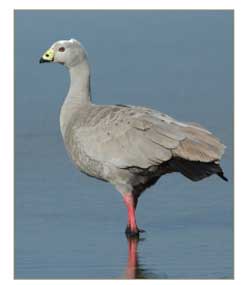
The Cape Barren Goose is a very large, pale grey goose with a relatively small head. Its stubby triangular bill is almost concealed by a very prominent greenish-yellow cere (skin above the bill). The Cape Barren Goose is found on the south-eastern coast of Australia, the southern coast of Western Australia and in south-eastern Victoria. It is locally dispersive and has been introduced to Kangaroo Island.
The Cape Barren Goose lays eggs in a nest in the tussocks of open grasslands. The nest is built by the male and lined with down. Each pair establishes a territory in autumn, prepares a nest and defends it noisily and determinedly against other geese. This species is monogamous, and pair-bonds are life-long. The female incubates the eggs and the young are brooded by both parents equally.
By the 1950s, numbers of the Cape Barren Goose were so low that biologists feared they may be close to extinction. Various initiatives have been taken which have increased the goose population to a level where they are no longer considered to be in danger. However, they remain one of the world’s rarest geese.
These are a protected species on Kangaroo Island however, they can be destructive from an agricultural point of view, as they are a grazing bird, by eating pasture and planted crop. Lucerne production at Stranraer can see damaged crops especially during the summer when feed is limited. On any given day through the summer, flocks of 200-300 birds can be seen on lucerne paddocks at Stranraer. With both Rush Lagoon and White Lagoon, Cape Barren Geese flock to the area in large numbers. The Cape Barren Goose is a protected species in Australia.
Sharp-tailed Sandpiper-Calidris acuminata
The Sharp-tailed Sandpiper is a medium sized wader with a straight black bill that has an olive-grey base. It has a chestnut crown and nape, a white eyebrow, and reddish brown upper parts, with each feather having a black centre. The rump and tail are black, with white outer margins visible in flight. This species is commonly seen with other waders during its migration from northern breeding grounds and is also one of the most abundant waders migrating to Australia each year.
The Sharp-tailed Sandpiper prefers the grassy edges of shallow inland freshwater wetlands. It is also found around swage farms, flooded fields, mudflats, mangroves, rocky shores and beaches.
It is strongly migratory, arriving in Australia in August, returning to Siberia in March, with greatest numbers in south-eastern Australia.
The Sharp-tailed Sandpiper feeds on aquatic insects and their larvae, as well as worms, molluscs, crustaceans and sometimes, seeds. It is often found in large flocks, often with other waders, foraging in shallow waters.
Black Swan-Cygnus atratus
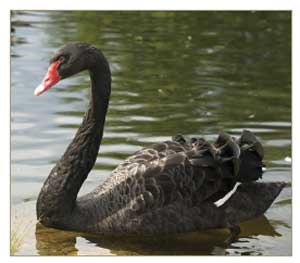
In adult Black Swans the body is mostly black, with the exception of the broad white wing tips which are visible in flight. Black Swans are found throughout Australia with the exception of Cape York Peninsula and are more common in the south. The Black Swan has been introduced into several countries, including New Zealand, where it is now common and is a vagrant to New Guinea.
Black Swans prefer larger salt, brackish or fresh waterways and permanent wetlands, requiring 40m or more of clear water to take off. Outside the breeding season, Black Swans travel quite large distances. Birds fly at night and rest during the day with other swans.
The Black Swan is a vegetarian. Food consists of algae and weeds, which the bird obtains by plunging its long neck into water up to 1m deep. Occasionally birds will graze on land, but they are awkward in their walking.
Black Swans form isolated pairs or small colonies in shallow wetlands. Birds pair for life, with both adults raising one brood per season. The eggs are laid in an untidy nest made of reeds and grasses. These can be seen during the spring period in certain areas of the farm, especially in the paddocks around Rush Lagoon that are low lying and become quite wet. The Black Swan will construct a nest that protrudes out of the water. The nest is placed either on a small island or floated in deeper water. These nests can be found across the farm. The chicks are covered in grey down, and are able to swim and feed themselves as soon as they hatch.
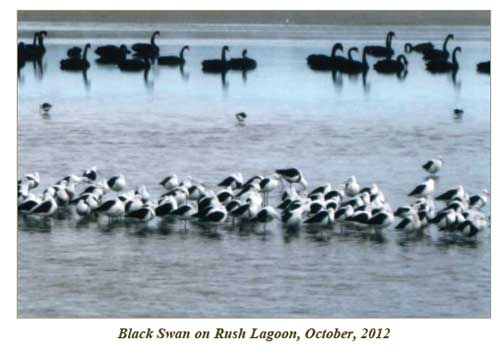
Black-winged Stilts and Black Swan on Rush Lagoon in January, 2013, as the water dries up in the summer months the bird concentration is high on the remaining water.
Yellow-billed Spoonbill-Platalea flavipes
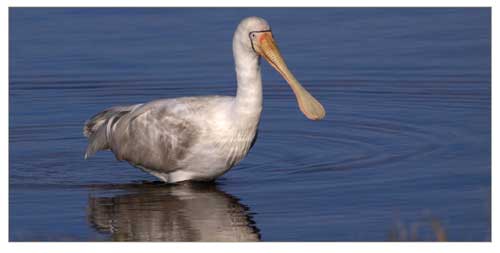
The Yellow-billed Spoonbill is a large, white waterbird with a yellow face and spatulate (spoon-shaped) bill, and yellow legs and feet. The Yellow-billed Spoonbill is found across Australia in suitable habitats, particularly in the north and well-watered inland areas, but is less common in coastal regions.
The Yellow-billed Spoonbill is found in the shallows of freshwater wetlands, dams, lagoons and swamps and sometimes in dry pastures, but rarely uses saltwater wetlands. It can use much smaller areas of water than the Royal Spoonbill. The Yellow-billed Spoonbill is nomadic and tends to feed in shallow water day and night preying on water insects. With their large bill they are able to sweep 120 degrees to collect insects on the water surface.
Glossy Ibis-Plegadis falcinellus
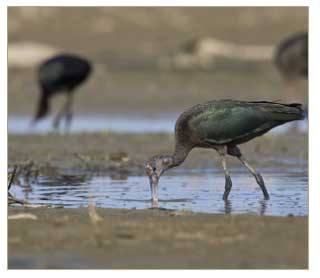
The Glossy Ibis is a small dark ibis that looks black in the distance. At close quarters the neck is reddish-brown and the body is a bronze-brown with a metallic iridescent sheen on the wings. The distinctive long, curved bill is olive-brown, the facial skin is blue-grey with a bordering white line that extends around the eyes. The eyes, legs and feet are brown.
The Glossy Ibis frequents swamps and lakes throughout much of the Australian mainland, but is most numerous in the north. It is a non-breeding visitor to Tasmania and the south- west of Western Australia.
The Glossy Ibis is both migratory and nomadic. Its range expands inland after good rains, but its main breeding areas seem to be in the Murray Darling Basin of New South Wales and Victoria, the Macquarie Marshes in New South Wales, and in southern Queensland. Glossy Ibis often move north in autumn then return south to their main breeding areas in spring and summer.
Glossy Ibis feed on frogs, snails, aquatic insects and spiders in damp places. They feed by probing the water and mud with their long, curved bill.
Diversion of water flow into wetlands for irrigation and other purposes disrupts breeding by restricting areas of shallow water. The Macquarie Marshes have suffered greatly in this regard over many years, with the resultant failure of the Glossy Ibis to nest there.
Banded Stilts-Cladorhynchus leucocephalus
Banded Stilts are endemic to Australia, mainly in the south and inland.
Banded Stilts are found mainly in saline and hypersaline (very salty) waters of the inland and coast, typically large, open and shallow.
Banded Stilts are dispersive and movements are complex and often erratic in response to availability of feeding and breeding habitats across the range. Populations may move to the coast or nearby when the arid inland is dry, returning inland to breed after rain or flooding.
Banded Stilts breed only in the arid inland when wetlands appear after rain or flooding and not much is known about their breeding habits. They breed on small islands in lakes, occasionally on sand-pits, bare patches of sandy clay or stony soil. The nest is a scrape in the ground, saucer-shaped or like an inverted cone. The nest is occasionally lined with dry grass or stems of samphire.
There is plenty of samphire present on Rush Lagoon for feeding by the Banded Stilts.
Black-winged Stilts-Himantopus himantopus
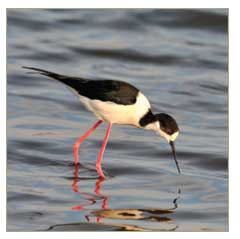
Black-winged Stilts are related to Banded Stilts, Cladorhynchus leucocephalus, which have a broad chestnut band across the breast (absent in young birds) and lack the black on the back of the neck. Young Banded Stilts can be separated from young Black-winged Stilts by their all white back and black wings. The legs of the Black-winged Stilt are the longest of any wader and aid in the feeding process by allowing it to wade into deeper water. They are often seen on the edge of Rush Lagoon wading for insects and provides an environment suited to its feeding regime.
The Black-winged Stilt is a social species and is usually found in small groups. Black-winged Stilts prefer freshwater and saltwater marshes, mudflats, and the shallow edges of lakes and rivers. Their movement is nomadic often travelling to new feeding grounds at night.
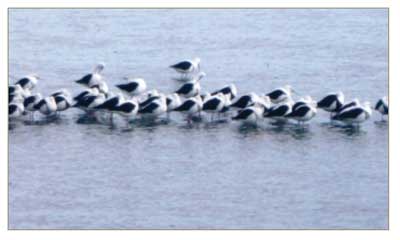
Black-winged Stilts on Rush Lagoon, January, 2013, as the water dries up on Rush Lagoon in February the bird concentration increases on the edges of evaporating water.
Red-necked Avocet-Recurvirostra novaehollandiae
The Red-necked Avocet has a chestnut brown head and neck with a white eye-ring and a long, upturned, black bill. The rest of the body is white, except for two black streaks along the back.
The Red-necked Avocet is found throughout mainland Australia, but breeds mainly in the south-western interior. Out of breeding season, it visits most of the rest of Australia, but is only an accidental visitor to Tasmania or the Cape York Peninsula.
The Red-necked Avocet is found in large shallow freshwater or saltwater wetlands and estuarine mudflats, whilst their movements tend to be nomadic in small flocks.
The Red-necked Avocet feeds on aquatic insects and their larvae, crustaceans and seeds. It wades in shallow water, sweeping its bill back and forth just below the surface to catch prey.
Royal Spoonbill-Platalea regia
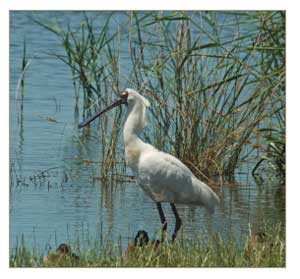
The Royal Spoonbill is a large white waterbird with black, spatulate (spoon-shaped) bill, facial skin, legs and feet. The Royal Spoonbill is most often seen wading in shallow waters, sweeping its submerged bill back and forth in a wide arc to find food.
The Royal Spoonbill is found in shallow freshwater and saltwater wetlands, intertidal mud flats and wet grasslands. Both permanent and temporary inland waters are used when available in the arid zone. It will also use artificial wetlands such as sewage lagoons, salt fields, dams and reservoirs.
The Royal Spoonbill will move with changing water availabilities.
White-faced Heron-Egretta novaehollandiae
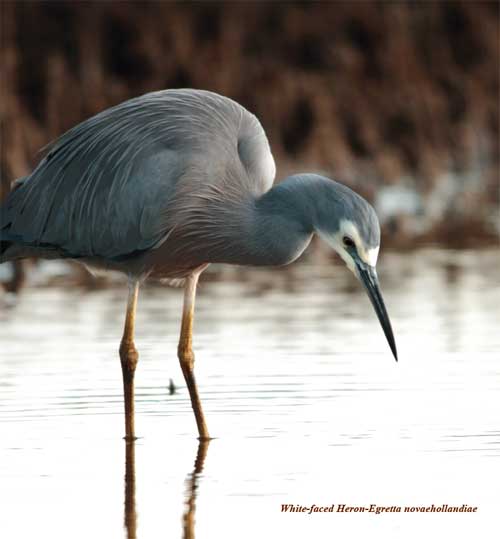
White-faced Herons are the most commonly seen herons in Australia. They are found throughout the mainland and Tasmania, and most coastal islands. They also occur in Indonesia, New Guinea, New Caledonia and New Zealand.
White-faced Herons can be found anywhere where there is water, from tidal mudflats and coastal reefs to moist grasslands and gardens.
Normally only one brood of young is raised in a year.
Australasian Grebe-Tachybaptus novaehollandiae
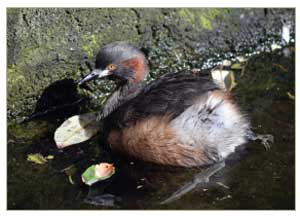
The Australasian Grebe is found throughout Australia and throughout the Pacific region. It is also self-introduced to New Zealand.
The Australasian Grebe is found in freshwater ponds or small waterways and is suited to the Rush Lagoon environment
Latham’s Snipe-Gallinago hardwickii
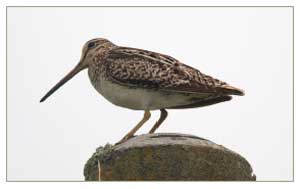
Latham’s Snipe is the largest snipe in Australia, with mainly brown, plumage. The bill is long and straight allowing it to feed into the water, the wings rather short and pointed and the tail is long. It has short legs and when folded, the wings project well past the tail, giving a pointed look. This species is also known as the Japanese Snipe.
The Latham’s Snipe annual nesting occurs in northern Japan and they tend to leave by August. With their migration from Japan, Latham’s Snipe tend to reach Australia especially Tasmania in September/October. The entire world population of Latham’s Snipe enter Australia after mid-August. The return journey is carried out in March/April.
Latham’s Snipe are seen in small groups or singly in freshwater wetlands on or near the coast, generally among dense cover. They are found in any vegetation around wetlands, in sedges, grasses, lignum, reeds and rushes and also in salt marshes and creek edges on migration. They also use crops and pasture for feeding.
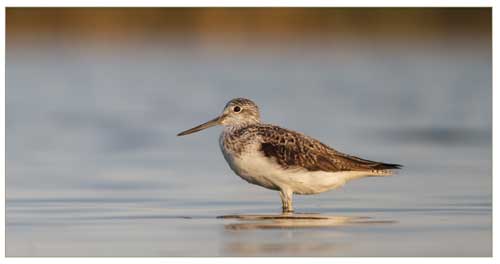
Common Greenshanks-Tringa nebularia
Common Greenshanks are found both on the coast and inland, in estuaries and mudflats, mangrove swamps and lagoons, and in billabongs, swamps, sewage farms and flooded crops. The common Greenshank is the most widely dispersed of Australian migratory waders, frequenting fresh, brackish and saline waters, which draw this bird to the White Lagoon wetland system.
Greenshanks arrive in Australia in August and numbers increase slowly until September, with larger numbers arriving until November. Following their arrival, they normally remain in the same location with some local movement. Birds move north again in March and April, back to their northern Eurasian breeding grounds.
Greenshanks feed mainly on insects, worms, molluscs, small fish and crustaceans, feeding both by day and night. They feed by picking from the surface, probing, sweeping and lunging at the edges of mudflats or shallows. They may walk along the shoreline and even chase small fish in the shallow water.
Silver Gull - Larus novaehollandiae
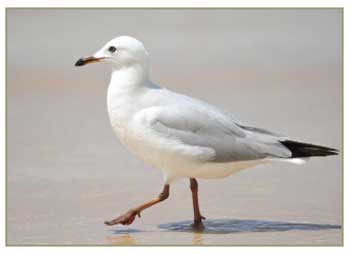
The Silver Gull has a white head, tail and underparts, with a light grey back and black-tipped wings. In adult birds the bill, legs and eye-ring are bright orange-red.
The Silver Gull is common throughout Australia and is also found in New Zealand and New Caledonia. Most commonly seen along coastal areas of Australia.
The Silver Gull is found at virtually any watered habitat and is rarely seen far from land. Birds flock in high numbers around fishing boats as these leave or return to the coast, but seldom venture far out to sea.
With greater access to a wide range of dietary items, the Silver Gull has been able to increase its population in areas of human activity. Available nesting grounds appear to be the only limiting factor to population increases. The Silver Gull can be seen behind cultivation machinery in the autumn period.
Little Grassbird - Megalurus gramineus
The Little Grassbird is found across eastern Australia and Tasmania, inland to central Australia and in south-western Australia. It is also found in New Guinea.
The Little Grassbird is found in swamps and marshes, preferring thick reed beds, and will occur in temporary wetlands after rains.
The Little Grassbird eats insects and other small arthropods, usually remaining in the dense cover of grasses and swamp vegetation and builds a deep cup nest of reeds and coarse grasses, lined with feathers, hidden in thick reedy vegetation.
The revegetation program at Stranraer has created a grassed and tussock environment around Rush Lagoon to protect the breeding for the Little Grassbird.
Masked Lapwing- Vanellus miles
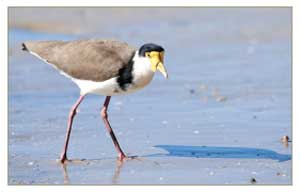
Masked Lapwings are large, ground-dwelling birds that are closely related to the waders. The Masked Lapwing is common throughout northern, central and eastern Australia. The Masked Lapwing inhabits marshes, mudflats, beaches and grasslands. It is often seen in urban areas. Where this bird is used to human presence, it may tolerate close proximity; otherwise it is very wary of people, and seldom allows close approach. The clearing for pasture and irrigation has increased their habitat in many regions and has resulted in large numbers congregating, even in city locations such as parklands.
Masked Lapwings feed on insects and their larvae as well as earthworms. Most food is obtained from just below the surface of the ground, but some may also be taken above the surface. Birds are normally seen feeding alone, in pairs or in small groups.
Wedge-Tailed Eagle-Aquila audax
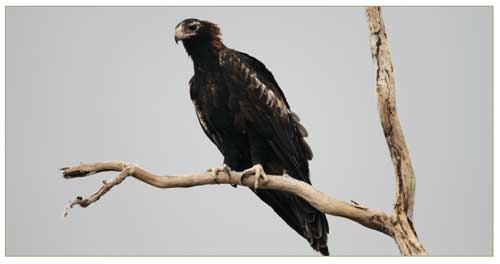
The Wedge-tailed Eagle has long wings (wingspan 2.3m), a characteristic long, wedge-shaped tail, and legs that are feathered all the way to the base of the toes. Wedge-tailed Eagles are Australia’s largest birds of prey.
The Wedge-tailed Eagle is found throughout mainland Australia, Tasmania and southern New Guinea and can be seen soaring high over the countryside covering large areas. Bounties have been paid for their destruction, primarily due to lamb losses in the mid 1900s, however, this species is now protected.
The timing of breeding may vary from location to location and from year to year according to the local availability of food. Both parents share in the duties of nest building, incubation and feeding of the young.
The Wedge-tailed Eagle is the most common of the world’s large eagles. It is nonetheless affected by several human activities. It has benefited by the opening of forests in eastern Australia and the increased availability of rabbits. Wedge-tailed Eagles however, are sensitive to forestry operations. In the more arid zones, extensive clearing has reduced the nesting resources. Nests can be seen on the northern edge of White Lagoon in the red gum tree populations and often they can be seen soaring above paddocks.
Black-tailed Native Hen-Gallinula ventralis
The Black-tailed Native hen is widespread throughout mainland Australia and in Tasmania and New Zealand.
The Black-tailed Native-hen is found near permanent or ephemeral terrestrial wetlands in low rainfall areas, in both fresh and brackish water.
The Black-tailed Native-hen is dispersive, with regular seasonal movements. Numbers may occasionally irrupt, determined by seasonal conditions and they may then use many habitats. Large numbers of Black-tailed Native-hens may arrive in an area then just as suddenly disappear again.
The Black-tailed Native-hen eats seeds, plant materials and insects. It feeds on open ground near wetlands or at the edge of water and often feeds by running, then stopping to stir up insects.
The Black-tailed Native-hen usually breeds near water in swamps, rank grasses or lignum. It is adapted to breeding rapidly when conditions are favourable. It makes a cup-shaped nest of stalks, twigs and leaves, lined with grasses and feathers. The Black-tailed Native hen follows the uncertain rains and floods of inland Australia, appearing on newly filled swamps in large numbers.
Australian Reed-Warbler (Acrocephalus stentoreus)
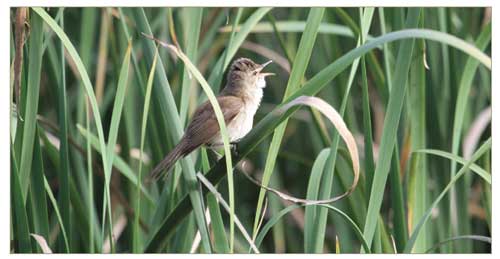
The Australian Reed-Warbler is found throughout Australia where there is suitable habitat and is also found from New Guinea to south-eastern Africa. During the winter period some will remain on wetlands in the southern states, however, most will travel north to Queensland and the Kimberleys. In September-October they return south and this is when they will appear on Rush Lagoon.
The Australian Reed-Warbler prefers dense vegetation alongside water, especially thick reed beds, as well as tall crops, bamboo thickets and lantana. The bull rush and reeds of Rush Lagoon is the type of habitat it prefers.
Australian White Ibis -Threskiornis molucca
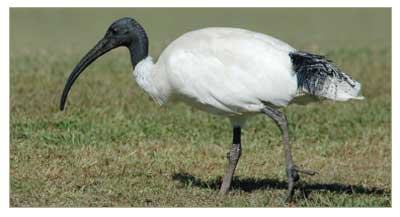
The Australian White Ibis is identified by its almost entirely white body plumage and black head and neck. The head is featherless and its black bill is long and down-curved.
The Australian White Ibis is common and widespread in northern and eastern Australia, and both its range and abundance in Western Australia is expanding, despite its absence from Western Australia prior to the 1950s. The species is absent from Tasmania.
The Australian White Ibis can be observed in all but the driest habitats. Preferred habitats include swamps, lagoons, floodplains and grasslands, but it has also become a successful inhabitant of urban parks and gardens. This species of bird can be seen all year round at Stranraer grazing on paddocks and finding insects, with a higher concentration occurring during the spring period.

Swamp Harrier-Circus approximans
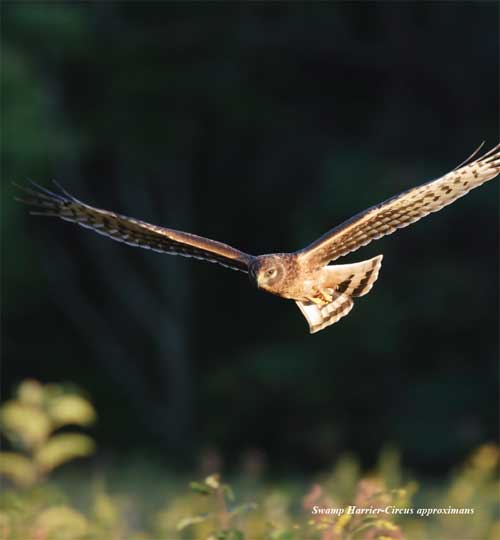
The Swamp Harrier is a large slim-bodied raptor (bird of prey), with long slender legs and a long tail, rounded at the tip. It is mainly dark brown above and the white rump is prominent. It is also known as the Marsh Harrier.
The Swamp Harrier is widespread in Australasia and the South Pacific. It is the most common raptor in New Zealand
The Swamp Harrier is found in terrestrial wetlands and open country of tropical and temperate Australia and New Zealand. It is mainly seen in fresh or salt wetlands, often in deep swamps with emergent reeds and over open water. In New Zealand it is more widely found, not just in wetlands. In Australia, the Swamp Harrier is partly nomadic and migratory, southern birds shifting north in winter and back to breed in the summer period.
Many of the Swamp Harriers in Australia move north in late summer and autumn and a few birds over-winter in Tasmania. They may migrate in groups and often roost communally (in groups) on the ground. These harriers may also disperse inland after heavy rain, whilst they rest, feed and roost on the ground.
Maned Duck or Australian Wood Duck-Chenonetta jubata
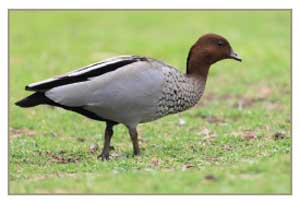
The Australian Wood Duck is widespread in Australia, including Tasmania.
The Australian Wood Duck is found in grasslands, open woodlands, wetlands, flooded pastures and along the coast in inlets and bays. It is also common on farmland with dams, as well as around rice fields, sewage ponds and in urban parks. It will often be found around deeper lakes that may be unsuitable for other waterbirds foraging, as it prefers to forage on land. The Australian Wood Duck eats grasses, clover and other herbs, and occasionally, insects. It is rarely seen on open water, preferring to forage by dabbling in shallow water, or in grasslands and crops. Flocks of up to 100 or even 1000 can be seen in southern parts of Australia through autumn and winter. During the breeding season these flocks disperse and pairs form on each of water ways to nes
Hardheads-Aythya australis
Hardheads are found in freshwater swamps and wetlands and occasionally in sheltered estuaries. They are rarely seen on land and tend to roost on low branches and stumps near the water. They prefer deep, fresh open water and densely vegetated wetlands for breeding.
Hardheads are dispersive and numbers may irrupt after good rain, with sudden increases in numbers.
Hardheads dive for their food, leaping forward and diving smoothly under the water. They eat aquatic plants and animals, particularly mussels and freshwater shellfish.
Hardheads have declined in some areas after draining of freshwater wetlands or diversion of water for irrigation.
Eurasian Coot-Fulica atra
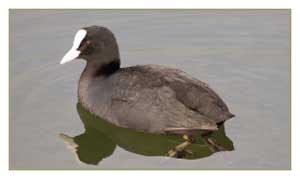
The Eurasian Coot is recognised by its snowy white bill and forehead shield. The Eurasian Coot ranges from Eurasia to Indonesia, New Guinea and Australia. Birds have also recently transported themselves to New Zealand, and the species is quickly becoming established.
In Australia the Eurasian Coot is common in suitably vegetated lagoons and swamps. Birds are less common in the north and in the drier regions.
Curlew Sandpiper-Calidris ferruginea
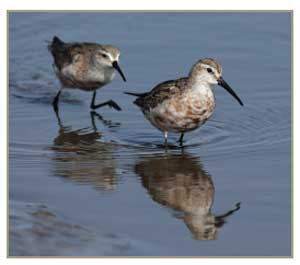
The Curlew Sandpiper is found on intertidal mudflats of estuaries, lagoons, mangroves, as well as beaches, rocky shores and around lakes, dams and floodwaters. Its breeding habitat is the lowland tundra of Siberia.
The Curlew Sandpiper is a migratory species from the Northern Hemisphere, moving south to Australia, Africa, the Persian Gulf, India and South-east Asia. It arrives in September and returns in April. The Curlew Sandpiper feeds on insects and their larvae when breeding. Otherwise, it feeds on small marine invertebrates, especially polychaete worms.
All waders are affected by coastal development, including drainage and land-clearing in their preferred habitats.